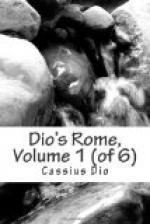Our historian’s sources for the earlier part of his work are not positively known. He has been credited with the use of Livy, of Coelius, of Appian, and of Dionysios of Halicarnassos, but the traces are not definite enough to warrant any dogmatic assertion. Perhaps he knew Tacitus and perhaps Suetonius: the portrait of Tiberius is especially good and was probably obtained from an author of merit. But there were in existence a great multitude of books inferior or now forgotten besides the works of the authors above mentioned; and Dio’s History in general shows no greater evidence of having been drawn from writers whom we know than from others whom we do not know.
We have already noticed Dio’s similarity to Thukydides in style, arrangement, and emotional attitude. There remains one more bond of brotherhood,—the speeches. Just as the sombre story of the Peloponnesian conflict has for a prominent feature the pleas and counterpleas of contending parties, together with a few independent orations, so this Roman History is filled with public utterances of famous men, either singly or in pairs. Dio evinces considerable fondness for these wordy combats ([Greek: hamillai logon]). About one speech to the book is the average in the earlier portion of the work. The author probably adapted them from rhetorical [Greek: meletai], or essays, then in existence. He was himself a finished product of the rhetorical schools and was inclined to give their output the greatest publicity. The most interesting of these efforts,—some go so far as to say the only one of real interest,—is the speech of Maecenas in favor of the establishment of monarchy by Augustus: this argument undoubtedly sets forth Dio’s own views on government. Like the rival deliverance of Agrippa it shows traces of having undergone a revision of the first draught, and it is more than probable that the two did not assume their present shape until the time of Alexander Severus.
B.—THE WRITER.
Suidas, the lexicographer of the tenth century, who is profitable for so many things, has this entry under “Dio”:
Dio—called Cassius, surnamed Cocceius (others “Cocceianus"), of Nicaea, historian, born in the times of Alexander son of Mammaea, wrote a Roman History in 80 books (they are divided by decades), a “Persia”, “The Getae”, “Journey-signs”, “In Trajan’s Day”, “Life of Arrian the Philosopher”.
Photius, an influential Patriarch of Constantinople and belonging to the ninth century, has in his “Bibliotheca” a much longer notice, which, however, contains almost nothing that a reader will not find in Dio’s own record. This is about the extent of the information afforded us by antiquity, and modern biographers usually fall back upon the author’s own remarks regarding himself, as found scattered through his Roman History. Such personal references were for the first time carefully collected, systematically arranged, and discussed in the edition of Reimar; subsequently the same matter was reprinted in the fifth volume of the Dindorf Teubner text.




